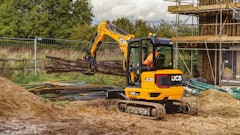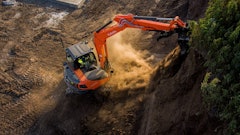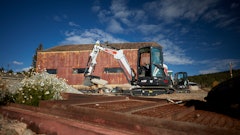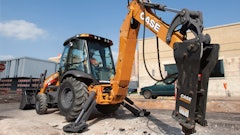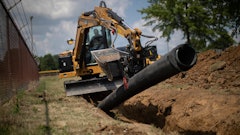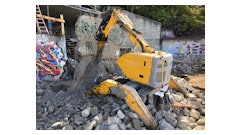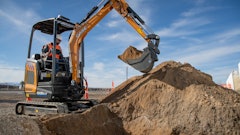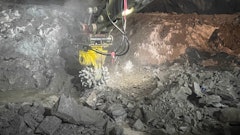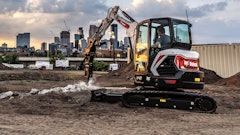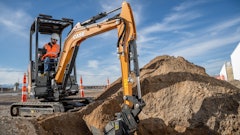
Keith Rohrbacker, Product Manager and Tim Boulds, Division Product Manger Construction Equipment
Kubota Tractor Corporation
Time is money, and for today's busy compact excavator operaters, lost time is lost money. In the current economy, operators are looking at increasing efficiencies and productivity and that means it is more important than ever to conduct regular maintenance when managing a compact excavator fleet. Choosing the right equipment and spending time on upkeep will not only prolong the life of the equipment, but will help save money - not to mention headaches and hassle - in the long-term both on replacement parts and down time.
Additionally, with high transportation costs in mind, no one wants to incur extra charges by transporting their equipment to the shop for costly repairs. Closer attention to maintenance schedules at the fleet storage site will help avoid multiple trips to the shop and keep the machine productive on the job site where there is work to be done.
Routine Maintenance - Daily Checks Not to Be Ignored
Even with easy-to-access maintenance features, an excavator that is running a large job or project will unfortunately often miss routine maintenance checks. All maintenance is important for extending the life and integrity of a machine, and there are a few routine procedures that should never fall to the wayside; no matter how busy the job.
The most important maintenance activities you can perform on compact excavators are the initial oil and filter changes. This is critical to maintain proper function of the engine, track motors, hydraulic system and air filter.
After the initial oil and filter changes, it is important to keep up with other routine maintenance as well. Make these checks part of the daily routine:
- Check engine and hydraulic oil levels. Checking engine and hydraulic oil levels should remain a daily priority. Factoring a few minutes to start the day with these two simple checks could save thousands of dollars in repair and replacement costs.
- Check the water and fuel separator. Checking for the presence of water in the fuel is an easy, yet crucial, daily check. Some excavators' fuel/water separators come with a red ring in a clear bowl, this red ring will float on water - making it nearly foolproof to monitor this potentially damaging fuel/water combination.
- Lubricate pivot points on the working group. Pivot points on the boom, dipper and bucket, along with the house swing bearing area, should be lubricated as indicated by the maintenance chart to reduce wear. These points need special attention when performing excavation work in water. When operating an excavator in water, generously grease before and after each use.
- Track adjustment. Track tension should be checked periodically or daily if the excavator is frequently in heavy use. Too loose of a track can result in poor maneuvering and lead to de-tracking, where the track comes off the idler and drive sprocket. Too tight of a track can cause premature wear and breakage. Both scenarios will cause down time and costly repairs.
Equipment Features that Make Maintenance Routines Easier
Ensuring that the compact excavator is equipped with features that help with easy routine checks is the first step of the maintenance process. If a machine is difficult to maintain, or if access to crucial operating components are challenging to reach, the reality is that it probably won't get done. Here are a few features that will help keep regular maintenance within reach:
- All grease points on one side of the boom. Greasing daily is one of the easiest, most cost-efficient, ways to keep an excavator running properly. Having all grease points on one side of the boom limits the need for the operator to move back-and-forth, across or under the boom for greasing. Other greasing features to look for include an easy-access grease gun storage compartment and a visible greasing schedule posted on the machine with a diagram. Keeping grease maintenance an easy-to-do, one person job, means that it is more likely to get done.
- Easy engine access. Look for a compact excavator with an engine compartment that is easy to access with a large door and color-coded filters and compartments. Many excavators on the market require the operator to crawl under the machine and physically unscrew wing-nuts to open the doors before they have access to the engine - checking the oil shouldn't be that hard. Find a machine that opens on the back, with full 180-degree access to batteries, oil filters, engine oil, air filters, and everything else that needs to be monitored on a regular basis. This is critical for ease of maintenance, but also as an added safety precaution, since the manual engine stop is also located in this area and should be easy to access.
- Electronic screen with maintenance reminders. Electronic panels are a tool that will notify an operator when maintenance is due and will also signify what errors the excavator is experiencing by use of error codes. This will help operators to identify and fix a problem before it causes significant damage. The best part? Electronic screens include programs to alert the operator of any potential problems every time the machine starts up, so it is a constant maintenance reminder. This is particularly helpful when multiple operators are running the machine If the machine doesn't come equipped with an electronic screen, then a visible maintenance chart is critical - so the operator doesn't have to reference the owner's manual for routine checks.
- Two-piece dozer hose. Dozer cylinder hoses are prone to damage because they are low on the track frame. Two-piece dozer hose fittings are on the front of the track frame rather than up and inside the machine. If damaged, the two-piece dozer cylinder hose design eliminates the need to lift, support, and crawl under the excavator. Shorter hoses are less expensive as down time is reduced.
With transportation and repair costs high, it is important to keep regular maintenance easy and routine. Asking each operator to, at the very minimum, perform the four checks above before starting the engine will help keep the machine on the job site at top performance instead of idle in the repair shop.






